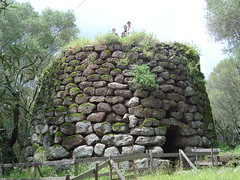
Traduzione by CARLO CARADONNA, volontario di English Gratis. Il testo originale è tratto da una pagina del sito inglese di Wikipedia ed è disponibile nel rispetto della licenza Creative Commons Attribution 2.5 ![]() photo credit: ntn6
photo credit: ntn6

Nuraghe
Il nuraghe
The nuraghe (IPA [nu’rage]) (plural Italian nuraghi, Sardinian nuraghes) is the main type of ancient megalithic edifice found in Sardinia, Italy.
Il nuraghe (IPA* [nu’rage]) (Plurale italiano ‘nuraghi’.Plurale nell’idioma sardo ‘nuraghes’) è il principale genere tra gli antichi edifici megalitici rinvenuti in Sardegna, Italia.
Today it has come to be the symbol of Sardinia and its distinctive culture, the Nuragic civilization.
Oggi è assurto a simbolo della Sardegna e della sua peculiare cultura, la civiltà nuragica.
According to the Oxford English Dictionary the etymology is “uncertain and disputed”: “The word is perhaps related to the Sardinian place names Nurra, Nurri, Nurru, and to Sardinian nurra heap of stones, cavity in earth (although these senses are difficult to reconcile).
Secondo l’ “Oxford English Dictionary” l’etimologia è “incerta e al centro di più dispute”: “Forse il lemma è correlato a nomi di località quali Nurra, Nurri, Nurru e al termine sardo ‘nurra’ sia nel significato di ‘cumulo di pietre’ che di ‘cavità nella terra’ (anche se queste accezioni sono difficili da conciliare).
A connection with the Semitic base of Arabic nür light, fire … is now generally rejected.”
Al momento viene unanimemente respinta una connessione con la radice semitica del vocabolo arabo nür luce, fuoco..”
The typical nuraghe is situated in a panoramic spot and has the shape of a truncated conical tower resembling a beehive.
Il tipico nuraghe è situato in un luogo panoramico e ha la forma di una torre conica troncata assomigliante ad un alveare.
The structure has no foundations and stands only by virtue of the weight of its stones, which may weigh as much as several tons.
La struttura non ha fondamenta e si regge solo grazie al peso delle sue pietre che possono pesare varie tonnellate.
>>> Some nuraghes are more than 20 metres in height.
Alcuni nuraghi hanno un’altezza superiore a 20 metri.
Today, there are more than 8,000 nuraghes still extant in Sardinia, although it has been estimated that they once numbered more than 30,000.
Oggi, vi sono più di 8.000 nuraghi ancora esistenti in Sardegna, anche se è stato stimato che un tempo gli stessi nuraghi ammontassero a più 30.000 .
Nuraghes are most prevalent in the northwest and south-central parts of the island.
I nuraghi sono presenti in misura più consistente nelle parti nord-occidentale e sud-centrale dell’isola.
There is a similar type of structure which has a corridor or a system of corridors.
Vi è una tipologia di struttura similare dotata di un corridoio o di un sistema di corridoi.
Some authors consider it inappropriate to call this type of structure a nuraghe and prefer the term “nuragic village”.
Alcuni autori considerano non appropriato chiamare questa tipologia di struttura un nuraghe e preferiscono la definizione di “village nuragico”.
The nuraghes were built between the middle of the Bronze Age (18th-15th centuries BC) and the Late Bronze Age.
I nuraghi furono costruiti tra l’Età del Bronzo Medio (18°-15° secolo A.C.) e l’Età del Bronzo finale.
Many were in continuous use from their erection until Rome entered Sardinia in the (2nd century BC), and perhaps later originated some of the current villages.
Dalla loro erezione fino alla venuta dei Romani in Sardegna (nel secondo secolo A.C.), molti di essi furono sistematicamente adibiti alla propria funzione; e forse successivamente diedero origine ad alcuni degli attuali villaggi.
According to Massimo Pallottino, a scholar of Sardinian prehistory and an Etruscologist, the architecture produced by the Nuragic civilization was the most advanced of any civilization in the western Mediterranean during this epoch, including those in the regions of Magna Graecia.
Secondo Massimo Pallottino, studioso della preistoria sarda ed etruscologo, l’architettura realizzata dalla civiltà nuragica fu la più avanzata rispetto a quanto sviluppato da qualsiasi civiltà presente nel Mediterraneo occidentale in quest’epoca, tra cui quelle civiltà originarie delle regioni della Magna Grecia.
Of the 8,000 extant nuraghes, only a few have been scientifically excavated.
Quanto agli 8.000 nuraghi ancora esistenti, soltanto per alcuni si è proceduto ad un’attivita scientifica di scavi archeologici.
The use of the nuraghes has not been determined: they could have been religious temples, ordinary dwellings, rulers’ residences, military strongholds, meeting halls, or a combination of the former.
Non è stata ancora determinata la destinazione dei nuraghi: potrebbero essere stati dei templi religiosi, dimore ordinarie, residenze dei regnanti, roccaforti militari, sale per assemblee, o un mix delle precedenti ipotesi.
Some of the nuraghes are, however, located in strategic locations – such as hills – from which important passages could be easily controlled.
Alcuni dei nuraghi sono, tuttavia, localizzati in posizioni strategiche – quali alture – dalle quali potevano essere facilmente controllati importanti passaggi.
Nuraghes could have been the “national” symbol of the Nuragic peoples.
I nuraghi potrebbero essere stati il simbolo “nazionale” dei popoli nuragici.
Small-scale models of nuraghe have often been excavated at religious sites (e.g. in the “maze” temple at the Su Romanzesu site near Bitti in central Sardinia).
Con l’attività di scavo archeologico spesso sono stati portati alla luce modelli in piccola scala di nuraghe presso dei siti religiosi (ad esempio nel tempio “labirinto” nel sito Su Romanzesu vicino Bitti nella Sardegna centrale).
Recent theories tend to suggest that Sardinian towns were independent entities (such as the city-states, although in a geographical sense they were not cities) that formed federations and that the building of these monuments might have depended on agreed-on distributions of territory among federated unities.
Recenti teorie tendono a suggerire che le città sarde fossero entità indipendenti ( quali le città-stato, anche se esse non erano città in un senso geografico) che formarono delle federazioni e che la costruzione di questi monumenti potrebbe essere stata dipesa dalle distribuzioni del territorio concordate tra le unità federate.
* IPA acronimo per International Phonetic Alphabet

